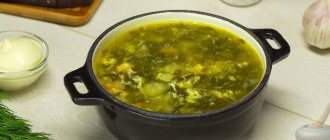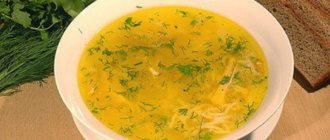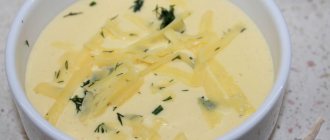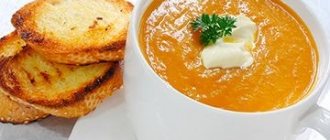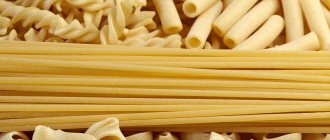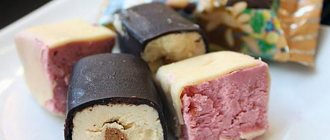Pea soup is a dish that many people like to treat themselves to. The main product in it is dried peas. During the cooking process, the peas boil and become soft, and the dish acquires a special taste and aroma. The calorie content of pea soup may be high, but the benefits of this dish are so great that it is simply stupid to deny yourself it. The benefits of peas were appreciated in ancient times. For example, the Romans and Greeks grew peas in 500-400 BC, and mention of pea soup can be found in the works of Aristophanes.
Pea soup is an international dish. Despite the different names, many countries around the world have been using it for centuries, regardless of the calorie content of pea soup. The composition of the dish remains virtually unchanged, but it is given different names. In Great Britain, this soup has been known since Roman times. The British pea soup recipe calls for peas, vegetables and bacon. In Germany, pea soup is a traditional dish. In addition to the peas themselves, various types of meat or meat products such as sausage and bacon are also added, although they can significantly increase the calorie content of pea soup.
The Dutch changed the recipe slightly and their pea soup contains split green peas, pork, celery root or stalk, onions, leeks, potatoes and carrots. A few minutes before it is ready, smoked sausages are added to the soup. Traditionally, this soup is consumed during the cold season. In Sweden and Finland, pea soup was made from yellow peas with pieces of pork. It was considered the ideal food for the pre-Lent day. In Ancient Rus', pea soup was valued for its nutritional qualities and excellent taste. The calorie content of pea soup was of little interest to our ancestors; rather, they appreciated the long feeling of fullness that was felt after a bowl of pea soup.
Modern housewives are more responsible about what and how their households eat, so the question of what the calorie content of pea soup is is of concern to many. This is especially important for people who are on a diet and want to lose weight. They are the ones who especially carefully count the calories in pea soup. They would certainly prefer this pea soup, which has minimal calories. This can be achieved if you carefully monitor the ingredients included in the dish. However, before counting the calories in pea soup, let's determine what is special about this dish and why it is so valued in different countries of the world.
Related Products
Chili soup (57 cal) Carrot coriander soup (100 cal) Lentil soup (54 cal) Vegetable soup (41 cal) Clear soup (8 cal) Chicken soup (60 cal) Potato soup (63 cal) ) Mushroom soup (51 kcal.) Tomato soup (43 kcal.) Bean soup (74 kcal.) Fish soup (ear) (16 kcal.) Turtle soup (53 kcal.) Onion soup (44 kcal.) Noodle soup ( 35 cal) Beef soup (50 cal) Vegetable pasta soup (44 cal) Broccoli soup (60 cal) Homemade soups (22 cal) Turkey soup (38 cal) Cream soups (52 kcal.) Meat soup (50 kcal.) Oyster stew soup (40 kcal.) Chinese soup (33 kcal.) Shark fin soup (46 kcal.) Cheese soup (76 kcal.)
Specific impact
In many cases, the dish causes discomfort in the intestines, which is due to the presence of special enzymes in dry peas that are responsible for inhibiting seed growth. They are not destroyed in boiling water. Once in the intestines, the components inhibit the breakdown of proteins of plant origin, which causes bloating and flatulence.
This fact places certain restrictions on the consumption of pea soup. First of all, people suffering from severe hemorrhoids should avoid this dish. If you know that your intestines are sensitive to legumes, you should take them in small quantities.
If you have urolithiasis and gout, you should not include dry pea soup in your diet. But a dish of green peas does not cause concern. It can be used even for chronic diseases of the gastrointestinal tract.
To avoid stomach discomfort, we recommend soaking dry peas for soup overnight.
Composition of nutrients, BJU
Pea soup
| For quantity: 100 grams | ||
| Calories — 67 | Calories from fat - 14 | |
| BJU | ||
| Total fat content | 1.5g | |
| Saturated | 0.7g | |
| Polyunsaturated | 0.16g | |
| Monounsaturated | 0.53g | |
| Cholesterol | 2mg | |
| Total carbohydrate content | 10.54g | |
| Dietary fiber | 2g | |
| Sugar | 3.53g | |
| Squirrels | 3.34g | |
| Vitamins and microelements | ||
| A - 3 µg | C - 0.57 mg | |
| B-6 – 0.03 mg | B-12 - 0.06mcg | |
| D - 0mcg | E - 0.09 mg | |
| Calcium 29mkg | Iron 0.81 mg | |
| Magnesium 17.33 mg | Zinc 0.66mg | |
| Potassium 97 mg | Sodium 212 mg | |
Distribution of calories for BJU:Carbohydrates (61%) Fats (20%) Proteins (19%) | ||
Positive effect on the body
This dish is a generous source of vitamins A, PP, C, E, group B. They help to quickly get back on your feet during a cold, prevent vascular and heart diseases, improve metabolic processes, and overcome depression and insomnia. Chicken soup or a lean version are recommended for people who want to lose weight. Since the dish contains only glucose and fructose, it can be consumed by patients with diabetes.
The rich mineral composition also has a positive effect on health. Peas contain iodine, zinc, iron, manganese, chromium, selenium, calcium and other important elements.
The soup contains a lot of potassium, which helps:
- lower blood pressure;
- overcome coronary heart disease;
- normalize the balance of potassium and sodium.
The presence of the important mineral selenium makes pea soup an ally in the fight against carcinogens and radionuclides. Legumes also contain pyridoxine, which is involved in the breakdown and synthesis of amino acids. Include pea soup in your diet and your hair and nails will become stronger.
Chicken Soup Recipe
Ingredients:
- 7-8 potatoes;
- 5 tbsp. l millet;
- chicken thigh - 1 piece;
- medium bulb;
- bay leaf - 3-4 leaves;
- one carrot;
- spices.
Practical part:
1. Remove the husk from the onion. The pulp must be finely chopped.
3. Let's start processing the potatoes. We clean and wash each of them. Then cut into cubes.
4. The carrots need to be peeled, washed and grated. Chicken soup, which is low in calories, turns out to be very aromatic and satisfying (due to the addition of millet).
5. Pour water into a deep saucepan (a little more than half). We put it on the stove. When the liquid starts to boil, add carrots, onions and potatoes. Immediately add the chicken thigh to the broth. There is no need to cut it.
6. Add millet only after the remaining ingredients are cooked.
7. We take out the thigh. Remove skin and bones. Cut the fillet into pieces. After 5 minutes, you can turn it off and pour the chicken soup into plates. The calorie content of this dish is 80-100 kcal (per 100 g of product).
Uses of peas
Previously, in Kievan Rus they often prepared pea soups, jelly and porridge, made noodles from peas, baked pies, and ate them fresh. In the old days, cooks knew much more recipes for pea dishes, as they appreciated its usefulness and nutritional value.
In other countries, peas were also in demand, but not equally. Thus, archaeologists conducting excavations in the Middle East found the fossilized remains of pea dishes: the age of these dishes is about 10,000 years.
In France, green peas were served to aristocrats as a delicacy, and in the eighteenth century this fashion came to Russia - although primitive people had long and quite willingly eaten a variety of pea dishes. The French, by the way, even then clearly divided the varieties of peas: traditional peas were eaten by commoners, and a liter container of green peas cost crazy cash - 150 francs, and even in gold.
By the way, in Greece, peas were also considered the food of the common people - the aristocrats lost a lot by abandoning this healthy and tasty product.
Today, soups and porridges are also made from peas, and fillings for pies and pancakes are prepared; There is even such a product as pea cheese - or rather, there was one, since its recipe is almost lost, and it can only be found in ancient books.
Chicken noodle soup
Ingredients:
- potatoes - 3 pieces;
- greenery;
- one carrot;
- 0.5 kg chicken breast;
- a few pinches of vermicelli (“Gossamer”);
- onion - 1 piece;
- spices.
Preparation:
1. Wash the chicken meat and divide it into several parts. Place in a saucepan with water and cook. Don't forget to remove the foam with a slotted spoon. When the chicken is cooked, remove it and strain the broth. Cut the meat into cubes. Pour the broth back into the pan. We put the chicken there too. We don’t turn on the fire yet.
2. Peel and rinse the onion and carrot. Chop the vegetables and sauté them in a frying pan using butter.
3. Turn on the fire. While the broth is heating, remove the skins from the potatoes. Cut the tubers into slices. Place into boiling broth. After 5-7 minutes, add the sautéed vegetables. The calorie content of soups prepared with chicken broth does not exceed 100 kcal/100 g.
4. Determine the softness of the potatoes using a spoon or fork. If the pieces crumble, then you can add vermicelli. Salt and pepper. Add your favorite spices. Boil for 5 minutes. Pour the soup into bowls. Sprinkle chopped herbs on top. Now your guests or family members can appreciate noodle soup. The calorie content of the dish is 46-50 kcal/100 g.
Medicinal properties of peas
Peas are one of the richest sources of vegetable protein, which the body needs as a building material for muscles and bones. It also provides a long-lasting feeling of fullness because, together with dietary fiber, it slows down the digestive process and raises the level of hormones that reduce appetite[6]. In terms of protein content, peas are often compared to meat, and often this vegetable becomes an integral part of the diet of vegetarians and vegans.
However, no matter how similar proteins of plant and animal origin may be, they are still not identical, so peas cannot become a complete meat substitute. By consuming this vegetable, the body does not receive enough of the essential amino acid methionine, which is involved in a large number of biochemical processes. For example, 100 g of peas contains only 0.082 g of methionine, and 100 g of beef contains 0.588 g.
On the other hand, scientists have come to the conclusion that high levels of methionine and its derivative, homocysteine, in the body lead to problems with blood vessels, blood clots, and activation of genes that provoke aging. It is best to maintain a balance and keep methionine in the area of the minimum norm. You can achieve this result by reducing your meat intake and adding other sources of protein, such as peas, to your diet.
Also, fresh green peas provide the body with a real vitamin boost. The vegetable is distinguished by a high concentration of B vitamins, and also contains vitamins C, PP, E, A, K. In addition, peas are rich in microelements such as potassium, magnesium, phosphorus, iron, zinc, selenium. All of these vitamins and nutrients often play a key role in many processes occurring in the body, and their deficiency can lead to serious diseases.
Note that a number of valuable acids enter the body along with peas. For example, glutamine is an essential element for the functioning of the brain. This neurotransmitter amino acid takes an active part in metabolism in brain tissue. Pantothenic acid is also indispensable in the body's metabolic processes. It also ensures the synthesis of cholesterol, hemoglobin, and histamine. Finally, it is difficult to overestimate the importance of folic acid, which is involved in the formation of red blood cells and helps normalize hematopoiesis.

How many calories are in pea soup
The calorie content of pea soup largely depends on whether this dish is lean or prepared with the addition of meat and meat broth. It should be said that even if there is no meat in the dish, the soup will still turn out hearty and tasty. This is probably one of the few soups in which the presence of meat is completely optional. So how many calories are in lean pea soup? The traditional recipe includes peas, potatoes, onions, oil for frying the onions and herbs. If, in addition, you do not add other high-calorie ingredients to the soup, then the calorie content of pea soup will be only 66 kcal per 100 g. This is a fairly low figure, so this soup can easily be included in your menu even for those who are on a diet. At the same time, the body will receive nutrients, vitamins and minerals, which are especially necessary for the body in the process of losing weight.
Despite the fact that even lean pea soup is a tasty dish, it is quite natural for gourmets to want to improve its taste. One of my favorite recipes is pea soup with cracklings. Cracklings are fried pork lard, so the calorie content of pea soup will increase significantly, because lard is a high-calorie product. But what a wonderful taste the resulting soup will have. In addition, its nutritional properties will significantly improve and it will be easily absorbed by the body. Usually, when preparing soup according to this recipe, fried lard is added to it a few minutes before it is ready. How many calories are in pea soup with cracklings? The energy value of such a dish will be equal to 300 kcal per 100 g. As you can see, the calorie content has increased almost 5 times. It is not surprising that those who watch their figure are wary of such soup, because by eating just 200 g of soup you can get as much as 600 kcal. If you really care about how many calories are in pea soup, you should choose recipes that are lower in calories. For example, pea soup with beef would be an excellent option. Beef is dietary meat, so the calorie content of pea soup will be relatively low, 172 kcal per 100 g. Pea soup can be varied as desired by adding different vegetables and seasonings to it. It all depends on the taste preferences of the cook. You can, for example, try to cook pea soup the way it is prepared in other countries. This will help pleasantly diversify the daily menu, and pea soup will never get boring.
Calorie table for second courses
Lunch should be the most satisfying meal of the day, but moderate in calories. The category of “highest fat and high-calorie dishes” listed in the table includes fried pork cutlets, breaded chicken and fish, and fast food from McDonald’s.
Calorie table for second courses
| Name of the dish | kcal Calories per 100 g | B Proteins, g | J Biry, g | Carbohydrates, g |
| Beef Goulash | 156,7 | 14,7 | 10,6 | 3,1 |
| Pork goulash | 237,3 | 13,9 | 16,6 | 3,2 |
| Steamed chicken cutlets | 127,5 | 14,9 | 5,2 | 2,7 |
| Fried chicken cutlets | 177,6 | 14,8 | 8,1 | 2,8 |
| Steamed turkey cutlets | 138,9 | 15 | 6,7 | 2,7 |
| Steamed fish cutlets | 86,8 | 14,6 | 1,6 | 2,9 |
| Fried fish cutlets | 142,3 | 14,5 | 5,9 | 2,9 |
| Steamed beef cutlets | 128,6 | 16,1 | 6,2 | 2,7 |
| Steamed pork cutlets | 203,3 | 15,2 | 10,9 | 3,1 |
| Chicken chop | 187,2 | 17,6 | 8,9 | 5,4 |
| Pork chop | 249,1 | 19,2 | 15,9 | 1,4 |
| Grilled or baked chicken | 179,8 | 18,3 | 8,3 | |
| Pork stewed or steamed | 256,5 | 13,8 | 18,1 | 3,4 |
| Beef stew | 178,9 | 14,7 | 12,4 | 3,2 |
| Cabbage rolls with minced meat and rice | 222,4 | 7,1 | 14,6 | 12,9 |
| Stuffed peppers | 179,8 | 6,9 | 11,1 | 10,1 |
| Liver stewed in sour cream | 151,1 | 16,2 | 6,8 | 5,6 |
| Fried liver with onions | 188,1 | 16,1 | 9,9 | 5,9 |
| Pollock fried in batter | 194,8 | 16,2 | 10,8 | 6,3 |
| Fried cod | 122,3 | 16,3 | 5,3 | 0,3 |
| Steamed salmon | 195,1 | 18,8 | 13,2 | |
| Baked pink salmon | 138,3 | 19,5 | 6,2 | |
| Meatballs (hedgehogs) with rice | 217,1 | 14,3 | 11,6 | 11,2 |
| Meat in French | 243,4 | 14 | 18,6 | 2,1 |
| Pilaf with chicken | 222,1 | 11,9 | 9,8 | 18,7 |
| Pilaf with pork | 265,4 | 13,2 | 12,6 | 17,3 |
| Beef pilaf | 218,8 | 13,4 | 9,1 | 18,9 |
| Cabbage stewed with meat | 143,7 | 11,1 | 5,6 | 10,5 |
| Fried potatoes with mushrooms | 122,4 | 2,6 | 7,3 | 12,9 |
| Potato dumplings | 178,1 | 3,9 | 4,5 | 32,3 |
| Dumplings with cottage cheese | 191,3 | 9,4 | 5,3 | 28,8 |
| Dumplings with cabbage | 142,2 | 3,6 | 4,1 | 23,1 |
| Homemade dumplings | 271,2 | 12,1 | 11,6 | 28,4 |
| Hamburger | 295 | 12,2 | 14,1 | 24,5 |
| California rolls | 176 | 7,1 | 8,9 | 17,2 |
| Philadelphia rolls | 142,2 | 9,1 | 6,9 | 12,9 |
